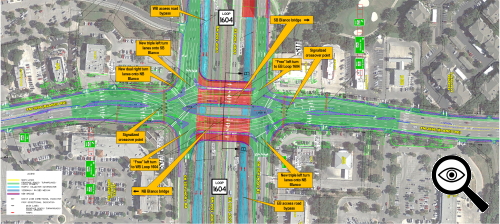|
||
|
|
||
This page last updated November 11, 2025 |
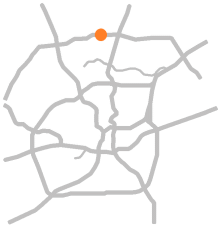
|
|

|
Location
Status
Timeline
|
|
ADVERTISEMENT |
On this page:
Summary
Here is a brief "PowerPoint" summary of this project:
- This project will convert the Blanco/1604 intersection to a "Diverging Diamond Interchange" (DDI).
- A DDI shifts traffic on the overpass to the opposite side of the road using two signalized crossover intersections.
- This allows through traffic and left turns from one direction of Blanco and left turns from one direction of the access road to move simultaneously, which is not possible in a conventional intersection.
- This overlap essentially doubles the traffic that can move through the intersection at one time.
- Access road through traffic is blocked by a DDI, so a frontage road bypass will be built to accommodate that traffic, which will completely remove that traffic from the intersection.
- While it seems confusing at first, it's actually pretty easy to navigate.
- Studies of past DDIs show improved safety as well as reduced congestion.
- DDIs have won widespread praise for their innovativeness.
Project description
This project will convert the access road intersections at Loop 1604 and Blanco Rd. (FM 2696) from conventional intersections to a "Diverging Diamond Interchange" (DDI).
The DDI will shift traffic in both directions on Blanco to the opposite side of the roadway just before crossing Loop 1604. Traffic will then travel over Loop 1604 to the left of opposing traffic (i.e. on the "wrong" side). Traffic turning left onto Loop 1604 will make a free left turn (i.e. no opposing traffic) while through traffic on Blanco will then cross back over to the right side of the roadway. The two crossover locations will be controlled by a traffic signal. (See the diagrams below for a depiction of these changes.) Shifting traffic over to the left side allows for two left turn movements that would normally be conflicting to occur simultaneously, thus allowing the intersection to move more traffic at one time. (More on that below.)
A DDI inherently blocks straight-through traffic on the access roads. To accommodate this through traffic, an access road bypass (known as a "collector/distributor road") will be built below Blanco next to but separate from the Loop 1604 mainlanes. Through traffic on the access road will descend to this road before reaching Blanco, pass under Blanco, then ascend back to the access road. This bypass roadway will also serve Loop 1604 traffic headed to and from Huebner and Stone Oak Parkway. This will take all that through traffic on the access roads out of the Blanco Road intersections. All of the entrance and exit ramps between Huebner and Stone Oak will be adjusted to accommodate the new collector/distributor roads.
In addition to the above, the project also will add the following:
- One additional through lane on Blanco (for a total of three) between Madera Parkway and Country Club Lane.
- An additional left turn lane (for a total of three) on both access roads at Blanco.
- A second right-turn lane from the westbound access road to Blanco.
This will be the first DDI in San Antonio and the eighth in Texas. The others are in El Paso, The Colony (north of Dallas), Round Rock, College Station, Georgetown, and two in Austin. The design has been used successfully in about 100 other locations around the US as well. Two other DDIs are planned for San Antonio: one at US 281 and Jones-Maltsberger and another at I‑37 and SE Military Dr.
TRAFFIC FLOW FOR BLANCO RD.
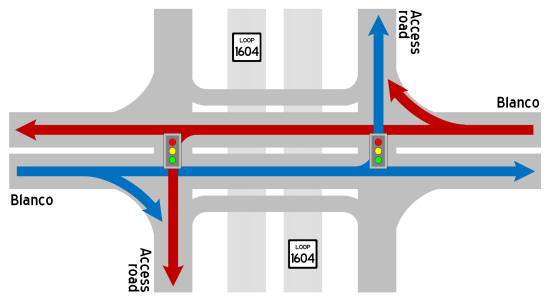
TRAFFIC FLOW FOR BLANCO RD.
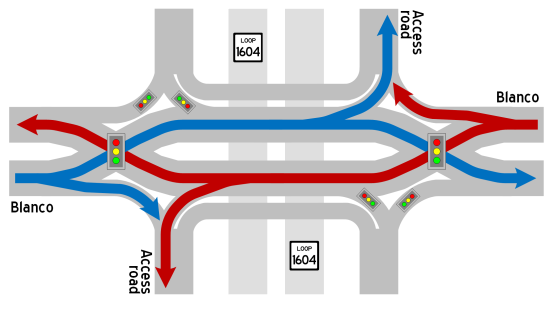
TRAFFIC FLOW FOR ACCESS ROADS
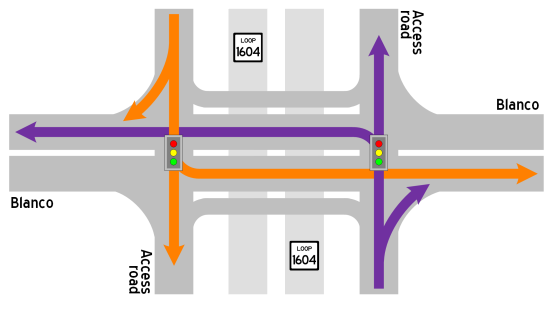
TRAFFIC FLOW FOR ACCESS ROADS
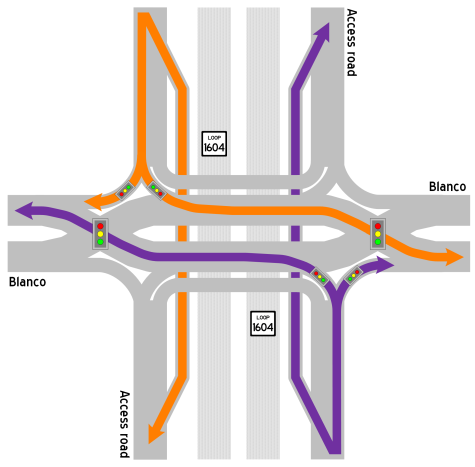
How this project will help
The DDI will help reduce current and expected future congestion at this intersection. Current and projected traffic volumes are sufficient to cause level of service "F" (congested) conditions during peak periods now and into the future. (You can learn more about levels of service here.) However, flyovers are not considered to be a good option for this location. Thus, this intersection is considered to be ideal for an "outside-the-box" (no pun intended) intersection design.
Computer modeling shows a dramatic improvement in this intersection's operation with this project. For example, it is projected that it would take through traffic on Blanco (either direction) 16 minutes to get through this intersection during the afternoon rush hour in 2037 with no improvements; with the DDI, it is projected to only take about four minutes. The left turn from eastbound Loop 1604 to northbound Blanco is projected to take 29 minutes during the afternoon rush hour in 2037 with no improvements, but also just four minutes with the DDI — an 86% improvement!
| No improvements | With DDI | |
| Blanco through traffic (NB and SB) | 16 min | 4 min |
| EB Loop 1604 left turn to NB Blanco | 29 min | 4 min |
 What is a signal phase? A signal phase is the green time assigned to a specified movement or collection of simultaneous movements in a traffic signal cycle. In other words, when the signal is green for a specific movement (straight through, left turn, etc.), that's a signal phase. When it changes to red and another movement gets a green signal, that's another phase. The complete rotation through of all of the phases is a cycle. |
The traffic turning left from the access road will encounter a red signal at the crossover point on Blanco where they will wait for opposing through traffic on Blanco to finish up. However, because both movements started at about the same time, the Blanco through traffic will be nearing the completion of their green by the time the left-turners reach that location, so the wait will be brief and more than offset by the overall reduction in delay that this intersection provides.
The diagrams below should help to illustrate the description above.
CONVENTIONAL INTERSECTION
Only one direction of traffic can go through the intersection at a time. This requires four signal phases to move traffic from all four
approaches. Right turns not shown.
Phase 1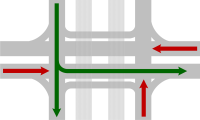 |
Phase 2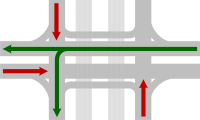 |
Phase 3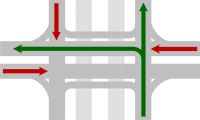 |
Phase 4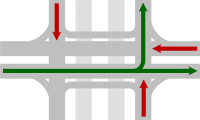 |
DIVERGING DIAMOND INTERSECTION
One direction of Blanco and one access road left turn can proceed at the same time. This requires only two signal phases to move traffic from all four approaches. Right turns from access roads are shown as they will be signalized. Right turns from Blanco will have a yield sign and are not shown.
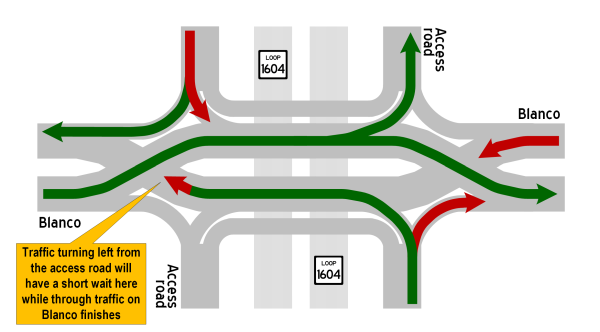
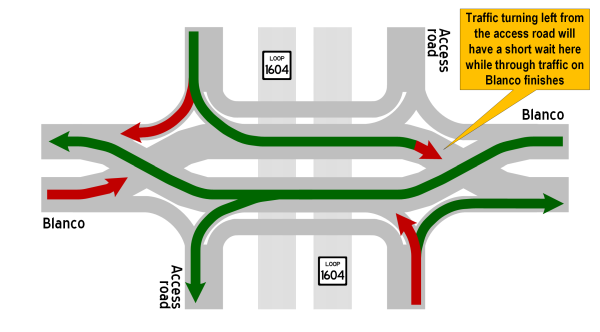
If each phase in the conventional intersection is 30 seconds, that's a cycle time of two minutes for all four phases. If each phase in the DDI is also 30 seconds, each cycle is just one minute, so two signal cycles can be completed in the same two minute period a conventional intersection would require for one cycle. In other words, each approach would get twice the amount of green time every two minutes than they would in a conventional intersection, meaning the intersection can move about twice as much traffic. (See example timings illustration below. Signal timings are for illustrative purposes only and do not represent actual timings. Timings are typically adjusted in response to traffic demand.)
Note that the description above is simplified to help explain the concept; the actual phasing and timing of signals is a bit more complex and may vary somewhat from what is described.
|
Example signal timings Below are simplified timelines showing example signal phase timings for each movement in the Loop 1604/Blanco Rd. intersection. Note that these timings are simplified for illustrative purposes only; they do not represent actual timings, and the actual phasing is a bit more complex and can vary throughout the day. Be sure to read the explanation above. |
|
Conventional intersection Only one direction can go at a time. If each direction gets 30 seconds of green time, that's a total cycle time of 120 seconds. 
|
|
DDI intersection 
|
Here is an animation that puts it all together. Note that this animation is greatly simplified and represents the "typical" DDI trafficflow. The phasing at Blanco and Loop 1604 could vary from this.
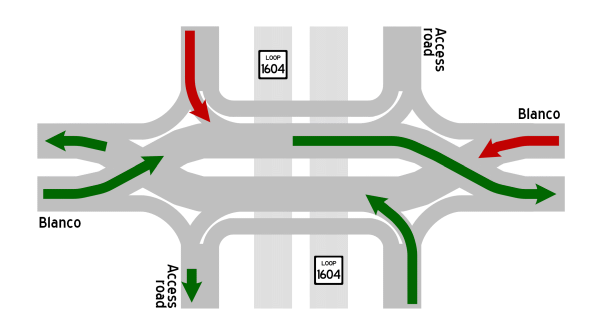
Additional lane markings and signage (including large overhead signs on Blanco) will help channel traffic into the correct lanes.
The crossover intersections will be angled sufficiently to make the crossover transition much more intuitive; engineers have learned the optimal angles for this from previous projects. Additionally, barriers will be placed between the opposing traffic lanes in the "wrong-side" area to obscure the oncoming traffic from view and thus reduce possible confusion or panic that might be caused by seeing oncoming traffic to your right.
While it probably looks and sounds confusing, driving through a DDI is actually far easier than it may seem from the diagrams and descriptions. See the video at the bottom of this page for a drive through.
Safety is also improved at DDI intersections. A DDI reduces the number of potential crash points from 26 to 14, with the worst type (side-angle collisions) reduced from 10 to just two. Additionally, a DDI physically prevents drivers from turning the wrong way onto the access roads, thus helping to prevent head-on collisions. A study at DDI intersections in Colorado showed a 36% reduction in crashes, and a 60% reduction was reported at a DDI in Springfield, Missouri where 97% of drivers surveyed reported they felt the DDI was safer than the previous conventional intersections.
Another possible drawback is that the DDI may be so efficient, it will cause increased congestion at other downstream intersections on Blanco as the additional traffic that gets through this intersection exceeds the capacity at those intersections.
Finally, as with anything new and unconventional, there will be some skepticism and initial confusion while drivers learn the new traffic patterns and adapt. And there are always some naysayers who will perpetually denigrate anything different, innovative, or outside their comfort zone or understanding. It's worth noting that there was much consternation on social media before the Displaced Left Turn intersection opened at Loop 1604 and Bandera in 2019, but widespread acclaim after it opened both for the congestion relief it brought as well as for it not being nearly as confusing as many had previously feared.
FAQ
- This looks confusing. It will cause lots of crashes.
While it may look complicated on the schematics, it's actually easy to navigate on the ground. See the video at the bottom of this page. Statistics from DDI implementations show a significant reduction in crashes, and practical experience from other DDI locations shows drivers quickly adapt to it. Many people predicted mayhem at the Bandera/1604 displaced left-turn intersection, but crashes decreased 40% in the first nine months the DLT was in operation, and the number of crashes in 2021 was less than half of those in 2016 and 2017 before construction began, despite equivalent traffic volumes. - How does this improve traffic?
This intersection design improves traffic because shifting the traffic to the left side of the road through the intersections removes the conflicts between left turns and opposing traffic found in a conventional intersection. As a result, traffic on two of the four legs of the intersection can move during a single green phase instead of needing four separate phases. This cuts the total number of signal changes required in half, thus moving about twice as much traffic through the intersection in the same amount of time. - The new third lane on Blanco needs to extend further or it will create a bottleneck.
The scope of this project was limited to this intersection and immediate vicinity. The additional lanes that will be added on Blanco are considered to be "auxiliary" lanes intended to help traffic get through the intersection and then smoothly merge back into the through lanes. If additional capacity is needed on Blanco beyond this point, that is a much larger project requiring separate study and additional funding. That said, TxDOT has said it will monitor the situation after implementation. Keep in mind that due to funding and other constraints, road improvements often need to be incremental, much like unkinking a hose one kink at a time. - It looks like there will be no straight-through traffic on the access roads. This will prevent access to nearby businesses, severely inconvenience drivers, and cause extra traffic on Blanco. This will also block westbound through traffic headed to Huebner.
It is correct that traffic on the access roads will have to turn left or right onto Blanco. Keeping the through movement on the access roads would cancel-out much of the improvement this design provides. However, an access road bypass will be provided below Blanco (next to the Loop 1604 mainlanes) that will allow most of the traffic that would normally go straight through the intersections on the access roads to instead pass below without stopping. This will have the major benefit of taking traffic going to and coming from Huebner out of the Blanco intersections. The ramps to and from this bypass will be located about 1000 feet from the Blanco intersection, so motorists going to or from businesses located between these points may need to turn onto Blanco and make a left or U‑turn to get to or depart from those locations. This will most especially affect the businesses right at the NE and SE corners. The shopping centers at the other corners have sufficient access points located away from the intersection that will minimize the affect of this change for them. While this is a bit of an inconvenience, it is no more so than what is required on streets with continuous medians or when accessing or leaving businesses along freeway access roads and is a small trade-off for the significant improvements this change will bring. - Will there still be turnarounds?
Yes, the turnarounds in both directions on Loop 1604 will remain. - Why not just add the additional turning and through lanes?
While this would help move more vehicles through the intersection on each cycle, the improvements would be short-lived as traffic increases to fill the new lanes. The DDI dramatically improves the underlying efficiency of the traffic signals themselves, which provides longer-term relief. - They should just widen the bridge on the westbound access road approaching Blanco — that's the bottleneck.
While it may seem like the bridge is a bottleneck because the road widens to five lanes after crossing it (and bridges sometimes just inherently seem constricting), the bridge is actually not the bottleneck. If it were, then traffic would be free-flowing once you get past the bridge, and that's obviously not the case. Instead, traffic backs up from the Blanco intersection onto the bridge and beyond. It's the intersection that's the bottleneck. Converting the intersection to a DDI will allow more green time for all approaches, which will increase the throughput through the intersection, thus reducing congestion on the approaches, including the bridge. Note that the same lane configuration without a bridge is present on the eastbound access road approaching Blanco, and it also suffers similar levels of congestion. - Why not build flyovers instead like the ones at Bandera and Loop 410?
This intersection does not have current or projected traffic volumes or patterns to justify flyovers and the additional right-of-way they would require. - How is this different than the new intersection at Bandera and Loop 1604?
The DDI is similar to the Displaced Left Turn (DLT) intersection completed in 2019 at Bandera and 1604 in that they are both considered to be types of "innovative" or "alternative" intersection designs that make signalized intersections function better by removing the inefficiencies caused by protected left turns. Both intersection designs do this by moving the left turns over to the other side of the road and out of the way of oncoming traffic. However, at the Bandera DLT, it is just the left turns that are shifted to the other side of the road, whereas a DDI moves both left-turning and through traffic over. A DLT has its crossovers further away from the main intersection and requires more signals and right-of-way than a DDI. Also, the DLT does not block through-traffic on the access road like a DDI does. Finally, a DLT does not also eliminate the conflicting left turns from the access roads to the cross street like a DDI does. - Why not build a DLT here instead of a DDI so that the through traffic on the access roads could be maintained?
There was not sufficient right-of-way at this location for a DLT, and acquisition of that right-of-way would have been cost-prohibitive. - Are any other DDIs planned in San Antonio?
Yes, two other DDIs are currently planned: one at SE Military Dr. and I‑37, and another at Jones-Maltsberger Rd. (South) and US 281. Other innovative intersections are also being planned for other locations; see the innovative intersections page for more info. - Who came up with this cockamamie design? This won't work and is just a waste of money.
The DDI design has been used in France since the 1970s and made its debut in the United States in 2009. It is now in use in over 100 locations in the US and internationally and has a proven track record of improving traffic and safety wherever it has been implemented. It is one of several types of "innovative" or "alternative" intersection designs being implemented across the country at intersections that do not warrant more expensive conventional upgrades (e.g. flyovers). TxDOT selected this design for this intersection after studying multiple other options. Computer modeling showed this design provided significant improvement in operations with substantial reduction in delays and improved safety. The DDI concept was hailed by Popular Science magazine as one of the top 100 innovations in 2009 and has been featured on National Public Radio (twice) and in Time, Fortune, and many other publications.
Schematics
Click on the images below to open the detailed schematics for this project from TxDOT with my own annotations added to help clarify and explain the various elements. Each schematic will open in a new window that you can scroll and zoom. These are the schematics presented to the public in March 2019, but match the final schematics for construction.

Video
I put together a video that discusses the Blanco Rd. DDI project, how it will work, and how it will improve traffic:
Other sites of interest
|
|
TxDOT - Loop 1604 at FM 2996/Blanco Rd public hearing https://www.txdot.gov/inside-txdot/ |
|
|
TxDOT - Loop 1604 at FM 2996/Blanco Rd visualization https://www.youtube.com/watch?v=TlYuEQXlCbw |
|
|
Wikipedia - Diverging Diamond Interchange https://en.wikipedia.org/ |
|
|
FHWA - Diverging Diamond Interchange Informational Guide https://www.trb.org/Main/ |
|
|
YouTube - How Diverging Diamonds Keep You From Dying https://youtu.be/A0sM6xVAY-A |
|
|
Alternative Intersections - Diverging Diamond Interchanges http://www.divergingdiamondinterchange.org/ |
|
|
The Diverging Diamond Interchange Website https://www.divergingdiamond.com/ |
|
|
TXDOT - DDI Fact Sheet (created for RM 1431 project but applies generally) http://ftp.dot.state.tx.us/ |
|
|
TxDOT - I‑35/RM 1431 Diverging Diamond Interchange Visualization https://www.youtube.com/watch?v=2i6_UYu-tfY |



